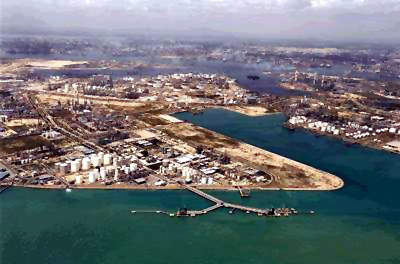
As part of the development of their downstream business in the Far East, Shell subsidiary Shell Eastern Petroleum constructed one of the world’s largest integrated petrochemical complexes.
With the ongoing demand for chemical resources produced from hydrocarbon feedstocks, Shell capitalised on its resources in Asia and brought the new facilities into production in May 2010. Shell remains committed to growing chemical investments in Asia Pacific and the new plant is another example of its ‘Grow East’ strategy.
The 800,000tpa ethylene cracker started production in March 2010. It also has a capacity of 450,000t of propylene and 230,000t of benzene. The EO / MEG plant uses feedstock from the ethylene cracker. The integrated refinery and petrochemicals complex was opened in May 2010.
The groundbreaking took place in October 2006. The MEG plant opened in November 2009.
The 800,000tpa ethylene cracker started production in March 2010. It also has a capacity of 450,000t of propylene and 230,000t of benzene. The EO / MEG plant will use feedstock from the ethylene cracker.
Demand for MEG from China and the rest of Asia is likely to increase to over 20,000kt by 2015 and Shell is determined to have the capacity to satisfy that demand.
The project employed a workforce of 15,000 at its site during construction, which took four years for completion. With a capital of SGD$4.1bn ($3bn), it represents Shell’s largest-ever chemical investment in Singapore.
Basic design and engineering
In July 2006, with Shell taking the final investment decision to build the petrochemicals complex, Foster Wheeler announced that its UK subsidiary, Foster Wheeler Energy (FWEL) and its Singapore subsidiary Foster Wheeler Eastern (FWEPL) were awarded contracts by Shell Eastern Petroleum (SEPL) for two basic design engineering packages (BDEP) associated with a global-scale EO / MEG plant and a significant refinery modification project in Singapore.
FWEL executed the BDEP for the new EO / MEG plant on Jurong Island and FWEPL executed the BDEP for modifications at the Pulau Bukom refinery, which is located on an adjacent island.
Petrochemical complex construction
Both the cracker and the EO / MEG plant are part of an overall investment programme, which includes integration of the new facilities with Shell’s existing refinery at Bukom to capitalise on the benefits of oil-chemicals integration.
The project scope also included modifications and additions to the Bukom refinery, which included a revamp of existing units, addition of new units (sulphur recovery and high vacuum), new and revamped tankage facilities, and tie-ins and interconnections. Modifications to the refinery were completed in 2010.
In March 2007 the first piles were driven on Pulau Bukom and Jurong Island. Land reclamation works by JTC Corp for the cracker project were successfully completed and handed over in January 2007. A dormitory to house 1,500 workers on the MEG plant on Jurong Island was completed in April 2007 and began operation from June onwards. A dormitory for staff working on the ethylene cracker was constructed on Pulau Bukom.
An ethylene jetty was constructed in October 2009. The jetty connects Pulau Bukom through refrigerated storage and undersea pipelines to MEG plant. During the same month, the first shipment of ethylene was also made to refrigerated ethylene storage facilities.
Butadiene extraction
During the final quarter of 2006 US-based ABB Lummus Global announced that it had been awarded a contract from Shell in relation to a 155,000tpa butadiene unit. The contract covers a licence and basic engineering of a grassroots facility.
In April 2007 Shell took the Final Investment Decision (FID) and launched a new butadiene extraction unit construction project in Singapore on Pulau Bukom.
The unit uses proprietary technology from ABB Lummus Global / BASF. This technology uses n-methylpyrrolidone as a solvent, which results in high-purity butadiene and low operating costs. The project is part of the Shell Eastern Petrochemicals Complex. Shell is one of the largest global marketers of butadiene and has contracted a large part of the new plant capacity for butadiene to customers.
Butadiene is used primarily in the production of polymers, co-polymers and chemical intermediates. Examples include styrene-butadiene rubber, polybutadiene rubber, adiponitrile and butanediol.
Additional contractors
In July 2005 TOYO was awarded the engineering, procuring and construction contract for the implementation phase of the Bukom Island ethylene cracker, in a joint venture with ABB Lummus Global.
Yokogawa Electric was selected by Shell in May 2007 to supply and fit automation systems for the new petrochemicals complex and the refinery upgrading.
Production
The cracker plant produces olefins and aromatics, basic feedstocks to be used by existing and new ventures on Jurong Island. Output from the new monoethylene glycol plant is expected to meet growing regional demand for this product.
The main products produced by the petrochemical complex include:
- ethylene – 800,000tpa
- propylene – 450,000tpa
- benzene – 230,000tpa
- monoethylene glycol – 750,000tpa
- butadiene – 155,000tpa
MEG plant technology
The monoethylene glycol plant incorporates technology to achieve the highest commercial yield from ethylene to glycol. Applying this technology ensures that much less water is used in the process and virtually no by-products are created, which is energy efficient.
The plant uses Shell’s OMEGA process, which combines a CRI high selectivity catalyst for the conversion of ethylene to ethylene oxide (EO) with a catalytic process to convert EO to glycol.
In the conventional EO / glycol process, ethylene reacts with pure oxygen at the ‘front end’ to produce ethylene oxide, producing CO2 as a by-product.
There is some distillation to clean off the EO and then it moves to the ‘back end’ glycol section.
A lot of water is used to react EO into MEG and by-products such as diethylene glycol (DEG) and triethylene glycol (TEG). The OMEGA process in the back end glycol section uses CO2 to convert EO into ethylene carbonate, which is then reacted with water to produce MEG with almost no by-products. Catalytic glycol production technology developed by Mitsubishi Chemical Corporation allows production of the final product.



